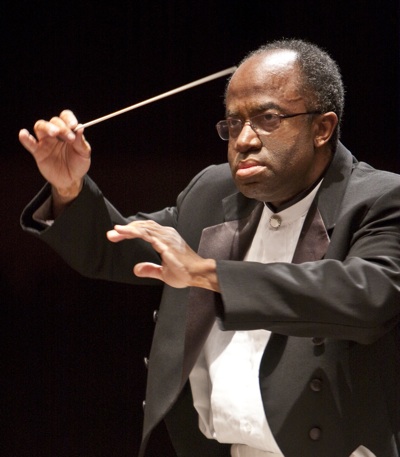Oakland Symphony packs them in – and packs a punch!
Balancing mysterious and stern passages with a crisp delivery, the Oakland East Bay Symphony joined the Oakland Youth Symphony and the Oakland Symphony Chorus in a massive undertaking – Hector Berlioz’ Requiem. Conceived to be a grand experience, Berlioz called for 400  musicians and singers at the premiere in 1837 at France’s grand Chapel of St. Louis.
musicians and singers at the premiere in 1837 at France’s grand Chapel of St. Louis.
Conductor Michael Morgan was able to stuff 250 instrumentalists and singers onto the stage of the cavernous Paramount Theater, where seasoned performers shared stands with enthusiastic youths for a thrilling journey. And as well, it was touching to see the raptness and humor between the generations.
The outsize effects that Berlioz required could have turned into musical mush if he had written this with the complexity of line and colorations for which he is known. Instead, lean lines were the order of the day, with ten French horns playing ponderous scales leading us up to Heaven – or down to Hell. Each careful blast made way for the next, and even the obligatory fugues were slowed to a stately interweaving of voices, rather than the full out gallop of the usual mass-as-spectacle.
I have seldom heard the Oakland Symphony Chorus sound so good. The basses were tight and stern, the tenors were clean and shaped their phrases to create moods of awe and mystery, the sopranos were bright and at times angelic, and the altos were adroit, balancing their inner harmony with muscle. And the whole was understandable due to their excellent diction (understandable, that is, in Latin).
I have also seldom seen Morgan conduct with such exactitude, wringing clarity out of a mob of performers, and to do so with shape and nuance.
My only regret was the amplification, which was used to balance the singers at the back of the deep stage with the doubled orchestra in front of them. The pickups tended to favor a small cluster of voices, generating a sound that was both overloud and thin. In parts of the auditorium this “necessary evil” sacrificed the careful blends of each section and their huge breadth of overtones, but up in the balcony I’m reliably told that the balance worked.
But then came the “Tuba Mirum,” the trumpets that announce the Day of Judgment, with four glorious groups of brass. Two were grouped onstage and two up in the balconies, so that the sound volleyed back and forth between the higher brass and their “earthly” brethren, with waves of sound and echoes that confounded the senses.
For someone who usually neglected religion, Berlioz managed to channel a strict and fearful faith, by turns awe-inspiring and penitent, all with a forbidding undertone.
In between brass volleys, the basses loosed their own sturdy ammunition, saving some thunder for the Agnus Dei. In the Quid sum miser, the tenors delivered longing and clarity, while the sopranos took the limelight with their gentle swaying in the Quaerens me, phrases attenuating into some ether that made the audience hold their breath.
 After the Lacrimosa, with its strangely operatic treatment of tearful Latin text, came the Offertorium, an impressive combination of mono-tonal vocals and orchestral color. This was one of the high points of the night. Then tenor soloist Thomas Glenn entered, another high point, for an outstanding job in the Sanctus, with gleaming high notes alternating with the women’s phrases.
After the Lacrimosa, with its strangely operatic treatment of tearful Latin text, came the Offertorium, an impressive combination of mono-tonal vocals and orchestral color. This was one of the high points of the night. Then tenor soloist Thomas Glenn entered, another high point, for an outstanding job in the Sanctus, with gleaming high notes alternating with the women’s phrases.
The hour-and-a-half long Mass finally wound down to gentle dreaming and the quiet rumble of kettledrum. One may wonder if Berlioz’ distant thunder was meant to remind us that after the concert, Judgment still awaits. This was a great close to another excellent season.
—Adam Broner
Photo top of Michael Morgan, by Eric Politzer; below, tenor Thomas Glenn, by Laura Bunker.
